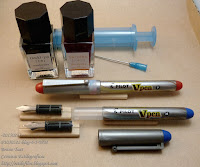 Two of the anniversary pens that Pilot did release. The "Fuji" and the "Meiji-Maru". The later was the most affordable anniversary pen at JPY 150000. (Picture taken from pilot.co.jp).
Two of the anniversary pens that Pilot did release. The "Fuji" and the "Meiji-Maru". The later was the most affordable anniversary pen at JPY 150000. (Picture taken from pilot.co.jp).
Sure enough you could accept the consolation offered by the series of Iroshizuku inks (JPY 1600, 50 ml) associated to some of the commemorative pens. However, that is a very minor token –a consumable token— if compared to a more substantial pen. But it might only be that I am not into inks.
The question, anyway, is what was in the minds of the marketing experts at Pilot to choose this strategy to celebrate its 100th anniversary. And this question is even more compelling when we see that Pilot did produce some limited edition pens for internal consumption celebrating the anniversary.
One of them is a Custom 74 in translucent blue.
This pen sports a dedicated cap ring with the inscription “PILOT 100th ANNIVERSARY SINCE 1918 JAPAN”. And the nibs is also signed accordingly: “PILOT / 100th / 14 K / <M>”, followed by the PP-F hallmark. Interestingly, this nib is not dated.
Not much information there exists about this pen save the note “not for sale”.
The Custom 74 is not just a black pen. On the contrary, it has been marketed in a number of colors and has become the canvas for some special editions. Consequently, it is not surprising to see it dressed as a commemorative pen.
But for some reason it was never for sale.
Pilot Capless, black trim – Lamy Dark Lilac
Bruno Taut
September 5th, 2022
etiquetas: Pilot, mercado
Bruno Taut
September 5th, 2022
etiquetas: Pilot, mercado












































